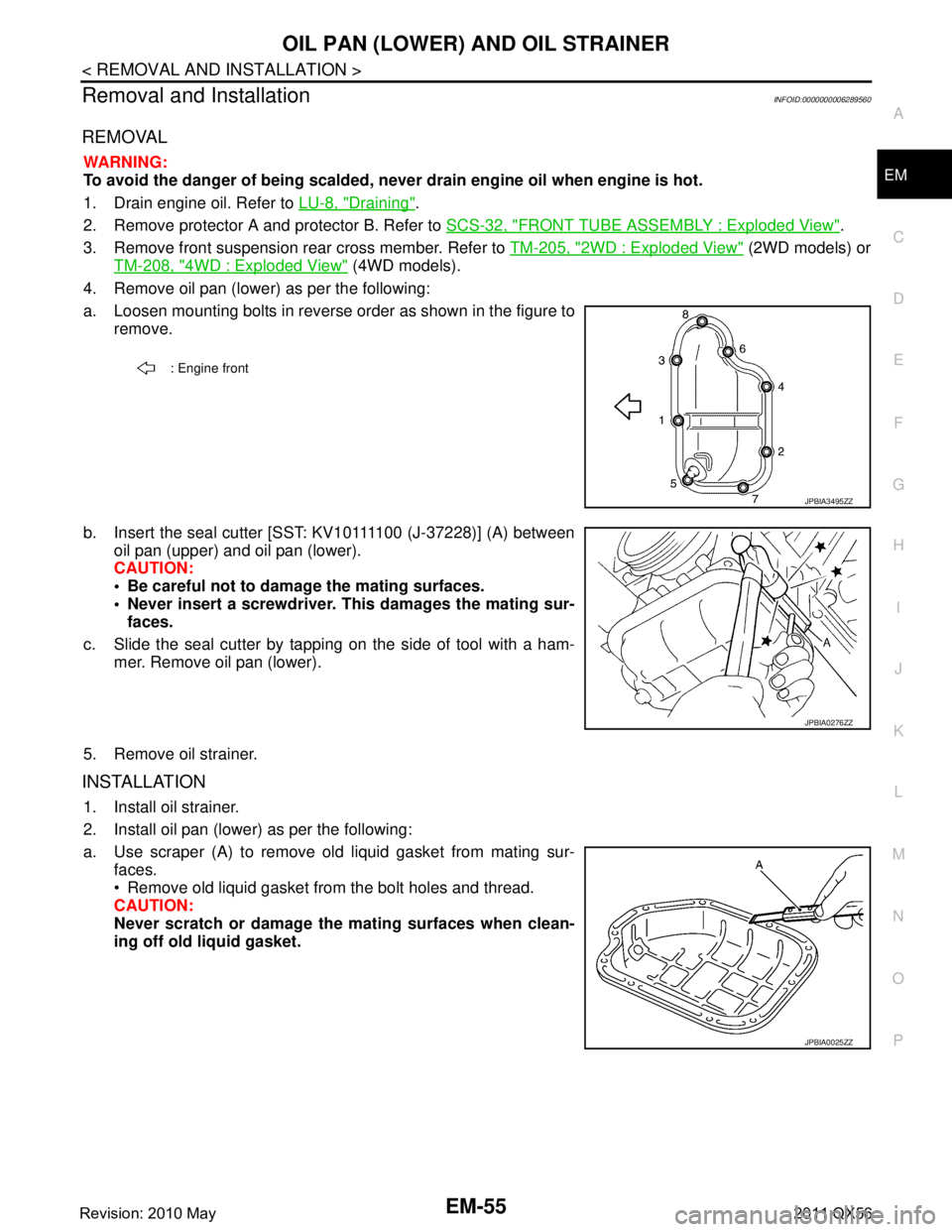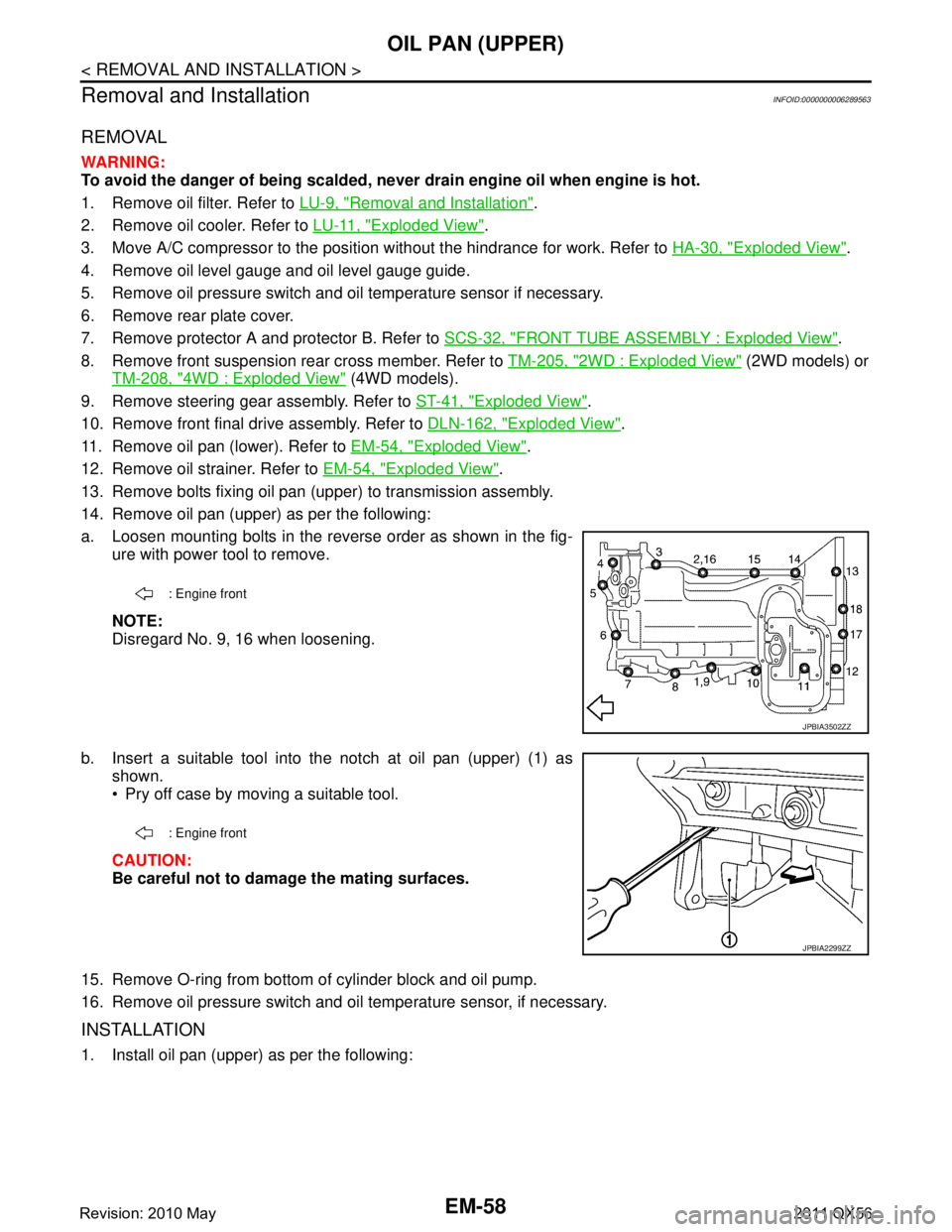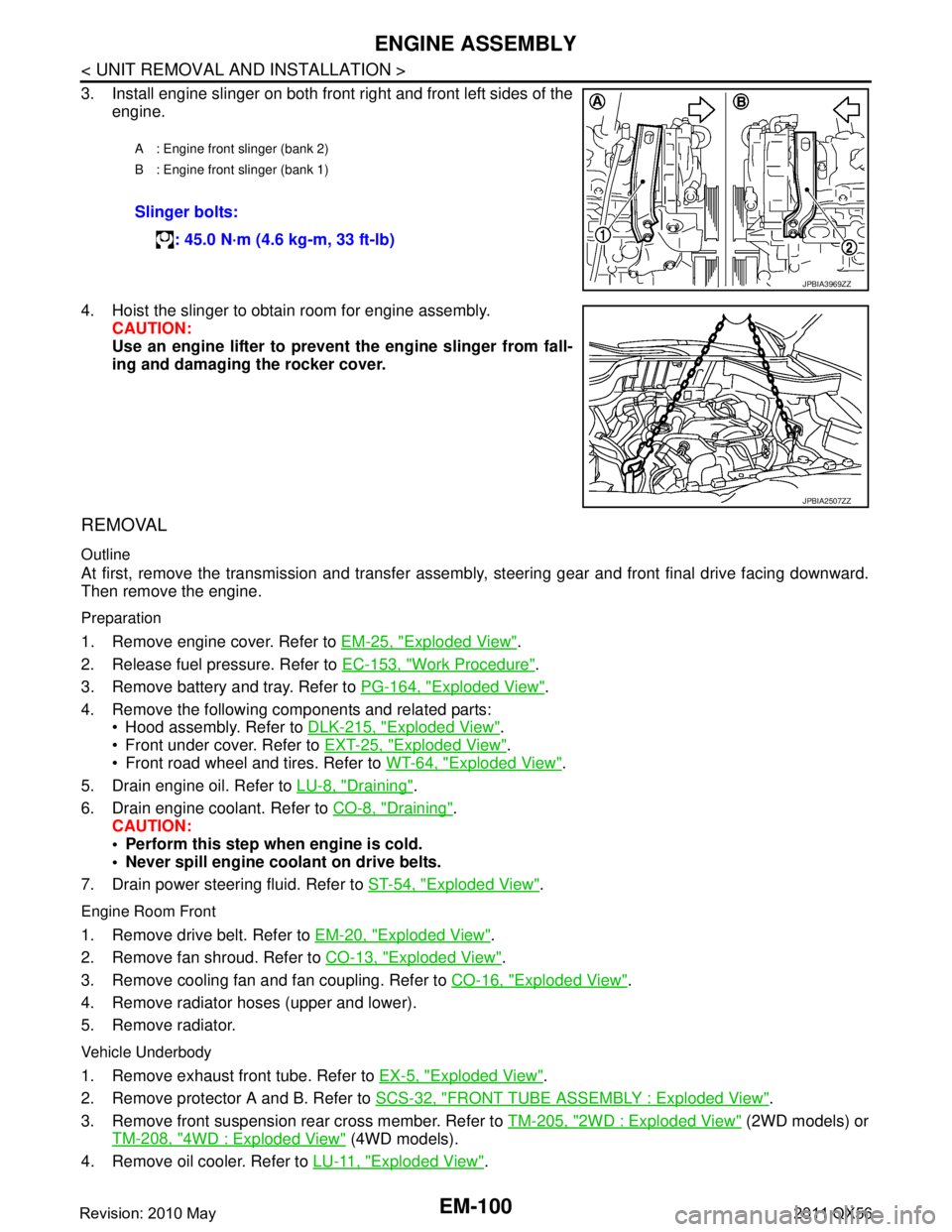2011 INFINITI QX56 suspension
[x] Cancel search: suspensionPage 1943 of 5598
![INFINITI QX56 2011 Factory Service Manual
NOISE, VIBRATION, AND HARSHNESS (NVH) TROUBLESHOOTINGDLN-141
< SYMPTOM DIAGNOSIS > [REAR PROPELLER SHAFT: 2S1410]
C
EF
G H
I
J
K L
M A
B
DLN
N
O P
SYMPTOM DIAGNOSIS
NOISE, VIBRATION, AND HARSHNESS ( INFINITI QX56 2011 Factory Service Manual
NOISE, VIBRATION, AND HARSHNESS (NVH) TROUBLESHOOTINGDLN-141
< SYMPTOM DIAGNOSIS > [REAR PROPELLER SHAFT: 2S1410]
C
EF
G H
I
J
K L
M A
B
DLN
N
O P
SYMPTOM DIAGNOSIS
NOISE, VIBRATION, AND HARSHNESS (](/manual-img/42/57033/w960_57033-1942.png)
NOISE, VIBRATION, AND HARSHNESS (NVH) TROUBLESHOOTINGDLN-141
< SYMPTOM DIAGNOSIS > [REAR PROPELLER SHAFT: 2S1410]
C
EF
G H
I
J
K L
M A
B
DLN
N
O P
SYMPTOM DIAGNOSIS
NOISE, VIBRATION, AND HARSHNESS (N VH) TROUBLESHOOTING
NVH Troubleshooting ChartINFOID:0000000006222436
Use the chart below to help you find the cause of t he symptom. If necessary, repair or replace these parts.
×: Applicable
Reference
DLN-142, "
Inspection
"—
—
—
—
DLN-142, "
Inspection
"
DLN-142, "
Inspection
"
NVH of FRONT FINAL DRI VE in this section.
NVH of REAR FINAL DRI VE in this section.
NVH in RAX and RSU section.
NVH in WT section.
NVH in WT section.
NVH in RAX section.
NVH in BR section.
NVH in ST section.
Possible cause and SUSPECTED PARTS
Uneven rotating torque
Center bearing improper installation
Excessive center bearing axial end play
Center bearing mounting (insulator) cracks, damage or deterioration
Excessive joint angle
Rotation imbalance
Excessive runout
DIFFERENTIAL
AXLE AND SUSPENSION
TIRE
ROAD WHEEL
DRIVE SHAFT
BRAKE
STEERING
Symptom Noise
××××××××××××××
Shake × × ××××××
Vibration ××××××× ×× × ×
Revision: 2010 May2011 QX56
Page 1956 of 5598
![INFINITI QX56 2011 Factory Service Manual
DLN-154
< SYMPTOM DIAGNOSIS >[FRONT FINAL DRIVE: R180A]
NOISE, VIBRATION AND HARSHNESS
(NVH) TROUBLESHOOTING
SYMPTOM DIAGNOSIS
NOISE, VIBRATION AND HARSHNESS (NVH) TROUBLESHOOTING
NVH Troubleshootin INFINITI QX56 2011 Factory Service Manual
DLN-154
< SYMPTOM DIAGNOSIS >[FRONT FINAL DRIVE: R180A]
NOISE, VIBRATION AND HARSHNESS
(NVH) TROUBLESHOOTING
SYMPTOM DIAGNOSIS
NOISE, VIBRATION AND HARSHNESS (NVH) TROUBLESHOOTING
NVH Troubleshootin](/manual-img/42/57033/w960_57033-1955.png)
DLN-154
< SYMPTOM DIAGNOSIS >[FRONT FINAL DRIVE: R180A]
NOISE, VIBRATION AND HARSHNESS
(NVH) TROUBLESHOOTING
SYMPTOM DIAGNOSIS
NOISE, VIBRATION AND HARSHNESS (NVH) TROUBLESHOOTING
NVH Troubleshooting ChartINFOID:0000000006222377
Use the chart below to help you find the cause of the symptom. If necessa ry, repair or replace these parts.
×: ApplicableReference
DLN-174, "
Inspection
"
DLN-171, "
Adjustment
"
DLN-174, "
Inspection
"
DLN-171, "
Adjustment
"
DLN-171, "
Adjustment
"
DLN-155, "
Inspection
"
NVH of FRONT PROPELLER SHAFT in this section.
NVH of REAR PROPELLER SHAFT in this section.
NVH in FAX, RAX, FSU and RSU sections.
NVH in WT section.
NVH in WT section.
NVH in FAX and RAX section.
NVH in BR section.
NVH in ST section.
Possible cause and SUSPECTED PARTS
Gear tooth rough
Gear contact improper
Tooth surfaces worn
Backlash incorrect
Companion flange excessive runout
Gear oil improper
PROPELLER SHAFT
AXLE AND SUSPENSION
TIRE
ROAD WHEEL
DRIVE SHAFT
BRAKE
STEERING
Symptom Noise
×××××××××××××
Revision: 2010 May2011 QX56
Page 1994 of 5598
![INFINITI QX56 2011 Factory Service Manual
DLN-192
< SYMPTOM DIAGNOSIS >[REAR FINAL DRIVE: R230]
NOISE, VIBRATION AND HARSHNESS
(NVH) TROUBLESHOOTING
SYMPTOM DIAGNOSIS
NOISE, VIBRATION AND HARSHNESS (NVH) TROUBLESHOOTING
NVH Troubleshooting INFINITI QX56 2011 Factory Service Manual
DLN-192
< SYMPTOM DIAGNOSIS >[REAR FINAL DRIVE: R230]
NOISE, VIBRATION AND HARSHNESS
(NVH) TROUBLESHOOTING
SYMPTOM DIAGNOSIS
NOISE, VIBRATION AND HARSHNESS (NVH) TROUBLESHOOTING
NVH Troubleshooting](/manual-img/42/57033/w960_57033-1993.png)
DLN-192
< SYMPTOM DIAGNOSIS >[REAR FINAL DRIVE: R230]
NOISE, VIBRATION AND HARSHNESS
(NVH) TROUBLESHOOTING
SYMPTOM DIAGNOSIS
NOISE, VIBRATION AND HARSHNESS (NVH) TROUBLESHOOTING
NVH Troubleshooting ChartINFOID:0000000006222410
Use the chart below to find the cause of the symp tom. If necessary, repair or replace these parts.
×: ApplicableReference page
DLN-215, "
Inspection
"
DLN-210, "
Adjustment
"
DLN-215, "
Inspection
"
DLN-210, "
Adjustment
"
DLN-210, "
Adjustment
"
DLN-193, "
Inspection
"
NVH of FRONT PROPELLER SHAFT in this section.
NVH of REAR PROPELLER SHAFT in this section.
NVH in FAX, RAX, and RSU sections.
NVH in WT section.
NVH in WT section.
NVH in RAX section.
NVH in BR section.
NVH in ST section.
Possible cause and SUSPECTED PARTS
Gear tooth rough
Gear contact improper
Tooth surfaces worn
Backlash incorrect
Companion flange excessive runout
Gear oil improper
PROPELLER SHAFT
AXLE AND SUSPENSION
TIRES
ROAD WHEEL
DRIVE SHAFT
BRAKES
STEERING
Symptom Noise
×××××××××××××
Revision: 2010 May2011 QX56
Page 2617 of 5598

OIL PAN (LOWER) AND OIL STRAINEREM-55
< REMOVAL AND INSTALLATION >
C
DE
F
G H
I
J
K L
M A
EM
NP
O
Removal and InstallationINFOID:0000000006289560
REMOVAL
WARNING:
To avoid the danger of being scalded, never
drain engine oil when engine is hot.
1. Drain engine oil. Refer to LU-8, "
Draining".
2. Remove protector A and protector B. Refer to SCS-32, "
FRONT TUBE ASSEMBLY : Exploded View".
3. Remove front suspension rear cross member. Refer to TM-205, "
2WD : Exploded View" (2WD models) or
TM-208, "
4WD : Exploded View" (4WD models).
4. Remove oil pan (lower) as per the following:
a. Loosen mounting bolts in reverse order as shown in the figure to remove.
b. Insert the seal cutter [SST: KV10111100 (J-37228)] (A) between oil pan (upper) and oil pan (lower).
CAUTION:
Be careful not to damage the mating surfaces.
Never insert a screwdriver. This damages the mating sur-faces.
c. Slide the seal cutter by tapping on the side of tool with a ham- mer. Remove oil pan (lower).
5. Remove oil strainer.
INSTALLATION
1. Install oil strainer.
2. Install oil pan (lower) as per the following:
a. Use scraper (A) to remove old liquid gasket from mating sur- faces.
Remove old liquid gasket from the bolt holes and thread.
CAUTION:
Never scratch or damage th e mating surfaces when clean-
ing off old liquid gasket.
: Engine front
JPBIA3495ZZ
JPBIA0276ZZ
JPBIA0025ZZ
Revision: 2010 May2011 QX56
Page 2620 of 5598

EM-58
< REMOVAL AND INSTALLATION >
OIL PAN (UPPER)
Removal and Installation
INFOID:0000000006289563
REMOVAL
WARNING:
To avoid the danger of being scalded, never drain engine oil when engine is hot.
1. Remove oil filter. Refer to LU-9, "
Removal and Installation".
2. Remove oil cooler. Refer to LU-11, "
Exploded View".
3. Move A/C compressor to the position without the hindrance for work. Refer to HA-30, "
Exploded View".
4. Remove oil level gauge and oil level gauge guide.
5. Remove oil pressure switch and oil temperature sensor if necessary.
6. Remove rear plate cover.
7. Remove protector A and protector B. Refer to SCS-32, "
FRONT TUBE ASSEMBLY : Exploded View".
8. Remove front suspension rear cross member. Refer to TM-205, "
2WD : Exploded View" (2WD models) or
TM-208, "
4WD : Exploded View" (4WD models).
9. Remove steering gear assembly. Refer to ST-41, "
Exploded View".
10. Remove front final drive assembly. Refer to DLN-162, "
Exploded View".
11. Remove oil pan (lower). Refer to EM-54, "
Exploded View".
12. Remove oil strainer. Refer to EM-54, "
Exploded View".
13. Remove bolts fixing oil pan (upper) to transmission assembly.
14. Remove oil pan (upper) as per the following:
a. Loosen mounting bolts in the reverse order as shown in the fig- ure with power tool to remove.
NOTE:
Disregard No. 9, 16 when loosening.
b. Insert a suitable tool into the notch at oil pan (upper) (1) as shown.
Pry off case by moving a suitable tool.
CAUTION:
Be careful not to damage the mating surfaces.
15. Remove O-ring from bottom of cylinder block and oil pump.
16. Remove oil pressure switch and oil temperature sensor, if necessary.
INSTALLATION
1. Install oil pan (upper) as per the following:
: Engine front
JPBIA3502ZZ
: Engine front
JPBIA2299ZZ
Revision: 2010 May2011 QX56
Page 2662 of 5598

EM-100
< UNIT REMOVAL AND INSTALLATION >
ENGINE ASSEMBLY
3. Install engine slinger on both front right and front left sides of theengine.
4. Hoist the slinger to obtain room for engine assembly. CAUTION:
Use an engine lifter to prevent the engine slinger from fall-
ing and damaging the rocker cover.
REMOVAL
Outline
At first, remove the transmission and transfer assemb ly, steering gear and front final drive facing downward.
Then remove the engine.
Preparation
1. Remove engine cover. Refer to EM-25, "Exploded View".
2. Release fuel pressure. Refer to EC-153, "
Work Procedure".
3. Remove battery and tray. Refer to PG-164, "
Exploded View".
4. Remove the following components and related parts: Hood assembly. Refer to DLK-215, "
Exploded View".
Front under cover. Refer to EXT-25, "
Exploded View".
Front road wheel and tires. Refer to WT-64, "
Exploded View".
5. Drain engine oil. Refer to LU-8, "
Draining".
6. Drain engine coolant. Refer to CO-8, "
Draining".
CAUTION:
Perform this step when engine is cold.
Never spill engine coolant on drive belts.
7. Drain power steering fluid. Refer to ST-54, "
Exploded View".
Engine Room Front
1. Remove drive belt. Refer to EM-20, "Exploded View".
2. Remove fan shroud. Refer to CO-13, "
Exploded View".
3. Remove cooling fan and fan coupling. Refer to CO-16, "
Exploded View".
4. Remove radiator hoses (upper and lower).
5. Remove radiator.
Vehicle Underbody
1. Remove exhaust front tube. Refer to EX-5, "Exploded View".
2. Remove protector A and B. Refer to SCS-32, "
FRONT TUBE ASSEMBLY : Exploded View".
3. Remove front suspension rear cross member. Refer to TM-205, "
2WD : Exploded View" (2WD models) or
TM-208, "
4WD : Exploded View" (4WD models).
4. Remove oil cooler. Refer to LU-11, "
Exploded View".
A : Engine front slinger (bank 2)
B : Engine front slinger (bank 1)
Slinger bolts:
: 45.0 N·m (4.6 kg-m, 33 ft-lb)
JPBIA3969ZZ
JPBIA2507ZZ
Revision: 2010 May2011 QX56
Page 2717 of 5598
![INFINITI QX56 2011 Factory Service Manual
COMPONENT PARTSEXL-7
< SYSTEM DESCRIPTION > [XENON TYPE]
C
D
E
F
G H
I
J
K
M A
B
EXL
N
O P
*1: With headlamp aiming control system (manual) models
*2: With AFS system models
EXTERIOR LIGHTING SYSTEM INFINITI QX56 2011 Factory Service Manual
COMPONENT PARTSEXL-7
< SYSTEM DESCRIPTION > [XENON TYPE]
C
D
E
F
G H
I
J
K
M A
B
EXL
N
O P
*1: With headlamp aiming control system (manual) models
*2: With AFS system models
EXTERIOR LIGHTING SYSTEM](/manual-img/42/57033/w960_57033-2716.png)
COMPONENT PARTSEXL-7
< SYSTEM DESCRIPTION > [XENON TYPE]
C
D
E
F
G H
I
J
K
M A
B
EXL
N
O P
*1: With headlamp aiming control system (manual) models
*2: With AFS system models
EXTERIOR LIGHTING SYSTEM : Component DescriptionINFOID:0000000006213888
1. Combination meter 2. BCM
Refer to BCS-4, "
BODY CONTROL
SYSTEM : Compon ent Parts Loca-
tion"
3. Optical sensor
4. IPDM E/R Refer to PCS-4, "
Component Parts
Location"
5. ECM
Refer to EC-16, "
Component Parts
Location"
6. Parking lamp
7. Front turn signal lamp 8. Front fog lamp 9. Headlamp
10. Front side marker lamp 11. Combination switch 12. Headlamp aiming switch*
1
13. Front door switch (driver side) 14.
Steering angle sensor*2
Refer to BRC-10, "Component Parts
Location"
15. License plate lamp
16. Tail lamp 17. Rear turn signal lamp 18. Rear side marker lamp
19. Hazard switch 20. Side turn signal lamp 21. Headlamp swivel actuator
22. Headlamp aiming motor 23. AFS switch*
224.Rear height sensor*2
25.AFS control unit*226.Front height sensor*2
A. Front combination lamp (back) B. View with instrument driver lower
panel (LH)C. Rear suspension member (RH)
D. View with instrument lower cover E. Front suspension arm (RH)
Part Description
BCM Controls the exterior lighting system.
ECM*
1Transmits engine speed signal to AFS control unit. (via CAN communication)
TCM*
1Transmits Shift position signal to AFS control unit. (via CAN communication)
IPDM E/R Controls the integrated relay, and supplies voltage to the load according to the request
from BCM (via CAN communication).
AFS control unit*
1AFS control unit judges the vehicle condition from each signal. AFS control unit con-
trols AFS function and the headlamp aiming.
Combination meter Outputs the vehicle speed signal (8-pulse) to AFS control unit.
Blinks the turn signal indicator lamp and outputs the turn signal operating sound with
integrated buzzer according to the request from BCM (via CAN communication).
Turns the tail lamp indicator lamp and high beam indicator lamp ON according to the
request from BCM (via CAN communication).
Turns the AFS OFF indicator lamp ON/OFF /blinking according to the request from
AFS control unit (via CAN communication).
Headlamp assembly Xenon bulb Refer to
EXL-8, "
FRONT COMBINATION LAMP : Xenon Headlamp".
HID control unit Refer to EXL-9, "
FRONT COMBINATION LAMP : HID control unit".
High beam solenoid Refer to EXL-9, "
FRONT COMBINATION LAMP : High Beam Solenoid".
Aiming motor Refer to EXL-9, "
FRONT COMBINATION LAMP : Aiming Motor".
Swivel actuator*
1Refer to EXL-9, "FRONT COMBINATION LAMP : Swivel Actuator".
Height sensor*
1
The height sensor is installed to the front suspension member and rear suspension member.
The height sensor detects the suspension arm displacement as the vehicle height change.
The height sensor transmits the height sensor signal to AFS control unit.
NOTE:
The sensor angle of the unloaded vehicle position is the reference value.
Optical sensor Optical sensor converts the outside brightness (lux) to voltage and transmits the opti-
cal sensor signal to BCM.
Revision: 2010 May2011 QX56
Page 2726 of 5598
![INFINITI QX56 2011 Factory Service Manual
EXL-16
< SYSTEM DESCRIPTION >[XENON TYPE]
SYSTEM
- Swivels the headlamp to the vehicle-center side until it hits the stopper.
- Returns the swivel angle from the stopper. Completes t
he initializatio INFINITI QX56 2011 Factory Service Manual
EXL-16
< SYSTEM DESCRIPTION >[XENON TYPE]
SYSTEM
- Swivels the headlamp to the vehicle-center side until it hits the stopper.
- Returns the swivel angle from the stopper. Completes t
he initializatio](/manual-img/42/57033/w960_57033-2725.png)
EXL-16
< SYSTEM DESCRIPTION >[XENON TYPE]
SYSTEM
- Swivels the headlamp to the vehicle-center side until it hits the stopper.
- Returns the swivel angle from the stopper. Completes t
he initialization with regarding the returned position
as the swivel angle 0 ° (straight-forward position).
Swivel Operation
AFS control unit transmits the drive signal to the sw ivel actuator when activation conditions are satisfied.
And swivels the headlamp.
- The swivel starts after steering approximately 20 ° or more from straight-forward position.
NOTE:
The steering angle differs between right turn and left turn.
- The swivel angle becomes the maximum angle toward t he driving direction if the steering angle is approxi-
mately 90 ° or more depending on the vehicle speed. The swivel angle is maintained by shutting off the drive
signal.
- The swivel starts, and returns to the swivel angle 0 ° (straight-forward position) when the steering is returned
to the straight-forward position.
AFS control unit returns the swivel angle to the strai ght-forward position, and stops the swivel regardless of
the steering angle if the operation condition is not satisfied while the swivel angle is 0°.
AFS OFF Indicator Lamp
AFS control unit transmits AFS OFF indicator lamp signal to the combination meter via CAN communication.
Combination meter turns AFS OFF indicator lamp ON /OFF/blinking according to AFS OFF indicator lamp
signal.
- AFS OFF indicator lamp is turned ON for 1 second for the AFS OFF indicator lamp bulb check when the igni-
tion switch is turned ON. AFS OFF indicator lamp is turned OFF within 1 second when the engine starts.
- AFS OFF indicator lamp turns ON when AFS is switched to “OFF” by operating AFS switch.
- AFS OFF indicator lamp blinks (1 second each) if AFS control unit detects a specific DTC.
NOTE:
Combination meter blinks AFS OFF indicator lamp (approximately 1 second each) if AFS OFF indicator
lamp signal is not received from AFS control unit.
HEADLAMP AUTO AIMING
Headlamp Auto Aiming Control Description
AFS control unit controls the headl amp light axis height appropriately according to the vehicle height.
AFS control unit detects the vehicle condition necessa ry for headlamp auto aiming control with the following
signals.
- Height sensor signals (front and rear)
- Vehicle speed signal (received from combination meter via CAN communication)
- Low beam status signal (received from IPDM E/R via CAN communication)
- Engine speed signal (received from ECM via CAN communication)
When the operation conditions are satisfied, AFS cont rol unit transmits the aiming motor drive signal for
adjusting the headlamp axis height.
Headlamp auto aiming operation condition- Headlamp ON
- While the engine running
- Vehicle speed (Control mode is switched according to the driving condition.)
Headlamp Auto Aiming Operation
AFS control unit calculates the vehicle pitch angle fr om the front and rear height sensor signal. AFS control
unit judges the angle for adjusting the axis gap from the preset position.
AFS control unit controls the headlamp axis by c hanging the aiming motor drive signal output according to
the front and rear vehicle height when detecting the follo wing vehicle condition. Output is maintained if other
condition than following is detected.
- Engine starts.
- Headlamp is turned ON.
- Vehicle posture becomes stable after changing the v ehicle posture change is detected with the headlamp
ON and the vehicle stopped.
- Vehicle speed is maintained with the headlamp ON and the vehicle driven.
CAUTION:
Adjusted axis position may differ from the preset position although the headlamp auto aiming acti-
vates properly if the suspension is replaced or worn.
Revision: 2010 May2011 QX56